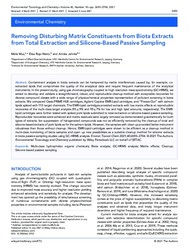Removing Disturbing Matrix Constituents from Biota Extracts from Total Extraction and Silicone‐Based Passive Sampling
Muz, Melis
Rojo‐Nieto, Elisa
Jahnke, Annika
DOI: https://doi.org/10.1002/etc.5153
Persistent URL: http://resolver.sub.uni-goettingen.de/purl?gldocs-11858/9810
Persistent URL: http://resolver.sub.uni-goettingen.de/purl?gldocs-11858/9810
Muz, Melis; Rojo‐Nieto, Elisa; Jahnke, Annika, 2021: Removing Disturbing Matrix Constituents from Biota Extracts from Total Extraction and Silicone‐Based Passive Sampling. In: Environmental Toxicology and Chemistry, Band 40, 10: 2693 - 2704, DOI: 10.1002/etc.5153.
 |
Dokument öffnen: |
Contaminant analysis in biota extracts can be hampered by matrix interferences caused by, for example, co‐extracted lipids that compromise the quality of the analytical data and require frequent maintenance of the analytical instruments. In the present study, using gas chromatography coupled to high resolution mass spectrometry (GC‐HRMS), we aimed to develop and validate a straightforward, robust, and reproducible cleanup method with acceptable recoveries for diverse compound classes with a wide range of physicochemical properties representative of pollutant screening in biota extracts. We compared Oasis PRiME HLB cartridges, Agilent Captiva EMR‐Lipid cartridges, and “Freeze‐Out” with salmon lipids spiked with 113 target chemicals. The EMR‐Lipid cartridges provided extracts with low matrix effects at reproducible recoveries of the multi‐class target analytes (93 ± 9% and 95 ± 7% for low and high lipid amounts, respectively). The EMR‐Lipid cartridges were further tested with spiked pork lipids submitted to total extraction or silicone‐based passive sampling. Reproducible recoveries were achieved and matrix residuals were largely removed as demonstrated gravimetrically for both types of extracts. Ion suppression of halogenated compounds was not as efficiently removed by the cleanup of total and silicone‐based extracts of pork lipids as for the salmon lipids. However, the samples with clean up provided better instrument robustness than those without cleanup. Hence, EMR‐Lipid cartridges were shown to be efficient as a cleanup method in multi‐class monitoring of biota samples and open up new possibilities as a suitable cleanup method for silicone extracts in biota passive sampling studies using GC‐HRMS analysis. Environ Toxicol Chem 2021;40:2693–2704. © 2021 The Authors. Environmental Toxicology and Chemistry published by Wiley Periodicals LLC on behalf of SETAC.
Statistik:
ZugriffsstatistikSammlung:
Schlagworte:
Multi‐class hydrophobic organic chemicalsBiota analysis
GC‐HRMS analysis
Matrix effects
Cleanup
Silicone‐based passive sampling
This is an open access article under the terms of the Creative Commons Attribution License, which permits use, distribution and reproduction in any medium, provided the original work is properly cited.

